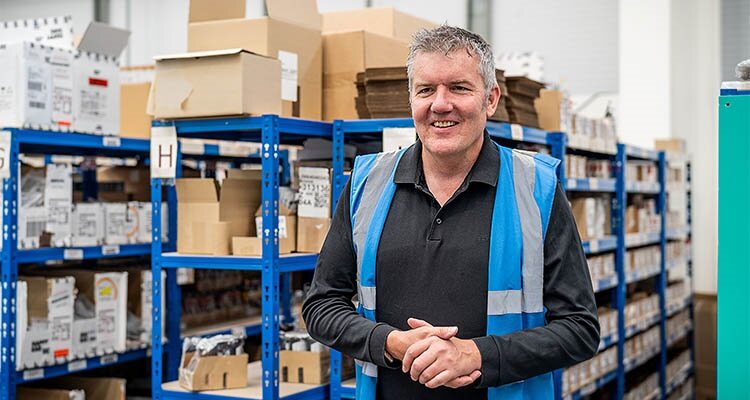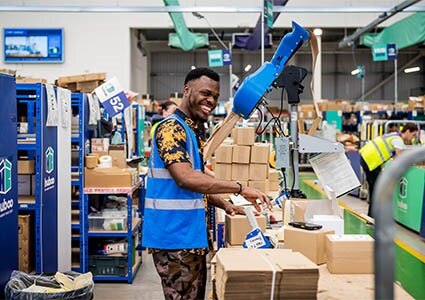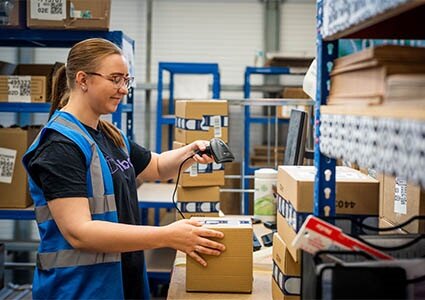
Paul Dodd, Chief Innovation Officer at Huboo shares insights into warehouse automation
1. Let’s start with an introduction to Huboo and its operations – how would you describe the company and its services?
We’re a global e-commerce fulfilment provider that takes care of selling, storing, and shipping products anywhere.
We’re headquartered in Bristol, and since 2017, we’ve been pioneering a new warehouse ‘hub’ model that houses items in smaller, self-contained hubs and uses technology to empower hub managers to deliver better client service.
We pride ourselves on our ability to combine best-in-class technology with a human-centric fulfilment network to offer scalable and affordable fulfilment to all e-commerce businesses, not just large organizations with deep pockets.
 2. What are the current limitations in warehouse automation?
2. What are the current limitations in warehouse automation?
Historically, automation has been good for handling single, standardized product categories but terrible at dealing with anything more complex. The problem for third-party logistics (3PL) providers is that if they rely on this type of crude automation, they end up turning away every client whose products don’t fit the bill.
Worse still, many of the big 3PLs have centered their day-to-day warehouse operations around robots and machines with limited functionality, effectively making their human team members subservient to them. This leads to meaningless jobs that no one wants to do, hence why the warehousing industry churn rate is so high.
3. More specifically, can you discuss the integration of AI and automation within warehouse logistics?
Until recently, every different automation use case has required a different robot or, at the very least, different tooling. With AI, the situation changes radically. It makes it much easier to build humanoid robots – or similar – that serve multiple use cases, and crucially, the tech will ensure the robots can adapt in real time to anything that doesn’t fit the brief.
Based on the current speed of AI advancement, I think we’ll see this type of advanced AI-powered automation on the warehouse floor in the near-to-mid-term. The question is how long it will take for the new tech to oust the old – and I think the jury is still out on this.
For example, non-flying drones are increasingly commonplace in warehouses to carry out tasks like stock taking. They’re preprogrammed with the details of their environment and use sensors to avoid hazards, and they’re often deployed out of hours, making them hugely efficient. 3PLs may see no good reason to turf these machines out and replace them with more expensive AI humanoid robots.
4. How is AI going to be a game-changer for the sector?
Generative AI and large language models (LLMs) have amazing potential in the field of robotics. AI-based image recognition is coming on in leaps and bounds, and when you put this technology into robots, you’re going to get a machine that is far more capable of adapting to its surroundings.
LLMs enable non-technical humans to converse with and issue interpretable commands to machines. Again, this could be transformative on the warehouse floor, allowing existing warehouse teams to direct the robots in the moment rather than requiring engineers to pre-program them beforehand.
5. How is Huboo positioned in this emerging landscape?
We’re in a great position to take advantage of the next wave of AI and automation solutions precisely because we’ve built our warehouses to be human-centric, reliant on skilled workers who use technology to empower them rather than the other way around.
We won’t need to reconfigure our warehouses to adopt these new technologies. If the next iteration of AI-powered robotics is more human-like, it will be very much at home in our hub environment and could be transformational in how we scale as a business.
For example, a human hub manager overseeing several AI robots can effectively manage a much larger hub without having to walk miles daily or getting overwhelmed by the volume of orders. They’ll be able to converse with the AI and get instant insights into operations, instant answers to client queries, instant, automated paperwork and other admin tasks processed. In this way, technology provides the pathway for us to create higher-value and more rewarding roles for our team.
6. Can you highlight any recent projects that demonstrate the business benefits of warehouse automation?
We’ve been using Dexory robots and drones in our warehouses since early 2022 to maximize how we use our space, ensure inventory accuracy and check that everything is stored in the right place. It’s proven a valuable solution that makes our hub managers’ lives easier, while by automatically scanning the entire warehouse on a daily basis, Dexory’s technology has enabled us to build a digital twin for each warehouse, something we can use to carry out real-time data analysis and insight into the storage of goods, without getting in the way of our warehouse teams.
7. Moving onto your own work background – how did you get where you are today?
After University, I joined Proctor & Gamble as a fresh-faced graduate. I ended up spending the next two decades there, initially as a Process Engineer before rising up the organization to become Global Physical Distribution Director, where I was responsible for driving organizational cost savings through the improvement of the company’s automation and transport systems.
Eventually, it was time for a change. I’d always wanted to do my own thing, and I had an idea for some warehousing and logistics tech that I began developing in my garage – this was effectively the first Huboo hub!
Then I met our Co-founder, Martin Bysh, at our kids’ football club. We started meeting for coffee regularly and chatting about the challenges of starting a new business, and the rest is history.
8. What do you think holds businesses back?
I think the biggest problem many businesses face is rigidity; not being agile enough to move with the times, especially now that things change so quickly. If your business structure can’t adjust to what’s happening in the external market quickly enough, you’ll get left behind.
9. Do you have any business advice that you consider essential?
Bring people along with you – this is always the key to being an effective leader and running a successful company. A quote from the former President of Proctor & Gamble, Richard Deupree, has always stood out to me. “If you leave us our money, our buildings and our brands, but take away our people, the company will fail. But if you take away our money, our buildings and our brands, but leave us all our people, we can rebuild the whole thing in a decade.”
10. What companies do you admire and why?
I’m hugely impressed by OpenAI, not just its speed of innovation, but its ability to establish and lead a new sector. Likewise, Tesla and SpaceX deserve great credit along similar lines, particularly given the complexity of the software/physical world integrations they face.
The latter is a similar type of challenge to the one we’re overcoming at Huboo – seamlessly blending the digital world of e-commerce with the very physical world of day-to-day fulfilment – so it’s always inspiring to see the latest Tesla and SpaceX R&D projects and compare them to our own innovations.